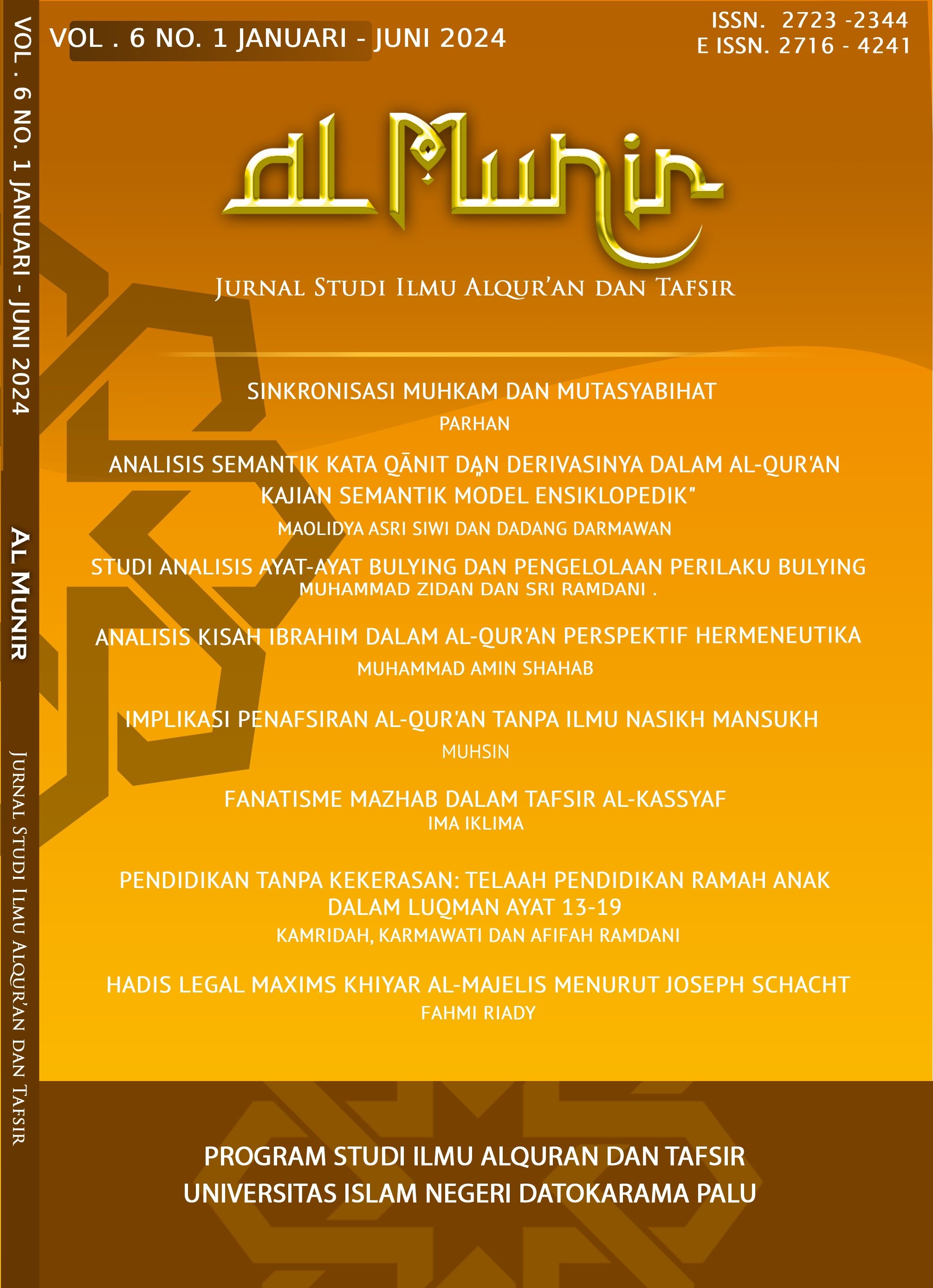HADIS LEGAL MAXIMS KHIYĀR AL-MAJELIS MENURUT JOSEPH SCHACHT
Abstract
According to Schacht, the study of legal maxims can be used as additional data to describe historically the growth of legal hadiths and the development of legal doctrine. The khiyār al-majelis hadith in the form of legal maxims can be placed in the context of this development. The focus of this study is Schacht's view regarding legal maxims hadiths, especially the khiyār al-majelis hadith. This article uses library research by using Joseph Schacht's work: The Origins as the main source. This research uses a qualitative-descriptive approach, with the documentary method as a data collection technique. The main problem in this study is analyzed historically-critically. The results of this research show that most legal maxims hadiths are a further development of the use of personal opinions and individual considerations of specialists and qāḍīs. The khiyār majelis hadith is an example of the process of developing legal doctrine in the form of legal maxims which later turned into hadith and have more complete isnād in classical colections. This last conclusion was refuted by A‘ẓamī who held the opposite view. And based on the results of the discussion, it seems that A‘ẓamī's criticism of Schacht's argument has not been very successful.
References
Al-Ḥumaidī. Musnad. Damaskus: Dār as-Saqā, t.t.
Apriliani, Intan Nur, Nadya Salsabila, and Putri Regina Wijaya. “Problematika Implementasi Khiyar Dalam Jual Beli Online.” Shar-E : Jurnal Kajian Ekonomi Hukum Syariah 9, no. 1 (March 11, 2023): 33–42. https://doi.org/10.37567/shar-e.v9i1.1539.
‘Asqalānī, Ibn Ḥajar al-. Fatḥu Al-Bārī Bi-Syarḥ Ṣaḥīḥ al-Bukhārī. Beirut: Dār al-Ma ‘rifah, 2001.
Asy-Syāfi‘ī, Muhammad ibn Idris. Al-Umm. Ed. Rif‘at Fawzī, Cet. I. ttp.: Dār al-Wafā, 2001.
A‘ẓamī, Muḥammad Muṣṭafā. Dirāsāt Fī Al-Ḥadīṡ an-Nabawī Wa Tārīkh Tadwīnihi. Beirut: al-Maktab al-Islāmi, 1980.
Bukhārī, Imām al-. Al-Jāmi‘ Aṣ-Ṣaḥīḥ. Kairo: al-Salafiyyah, 1400.
Djafri, Muhammad Taufan, Askar Patahuddin, and Muhammad Ridha. “Khiyār Al˗majlis Dan Aplikasinya Dalam Jual Beli Modern (Studi Komparatif Antara Jumhur Ulama Dan Imam Malik),” n.d.
Hafizah, Yulia. “Khiyar Sebagai Upaya Mewujudkan Keadilan Dalam Bisnis Islami,” n.d.
Hasan, Asy-Syaibānī ibn al-. Al-Muwaṭṭa’ al-Imām Mālik. ‘Abd al-Wahhāb. Kairo: Lajnah Iḥyā at-Turāṡ, 1994.
Ibn al-Ḥanbal, Aḥmad. Musnad Al-Imām Aḥmad Ibn al-Ḥanbal. ttp.: tp., 1978.
Jamilah, Jamilah, and Firmansyah Firmansyah. “Tinjauan Fikih Muamalah Terhadap Penerapan Khiyar Dalam Transaksi E-Commerce.” JURNAL EKONOMI DAN PERBANKAN SYARIAH 6, no. 1 (August 26, 2019): 49–62. https://doi.org/10.46899/jeps.v6i1.87.
Jazarī, Ibn al-Aṡīr al-. Jāmi‘ al-Uṣūl Fī Aḥādīṡ Ar-Rasūl. ttp.: Maktabah al-Ḥilwānī, 1969.
Juynboll, G.H.A. Muslim Tradition: Studies in Chronology, Provenance, and Authorship of Early Hadith. London: Cambridge University Press, 1983.
———. Studies on The Origins Uses of Islamic Hadith. Great Britain: Variorum, 1996.
Kamali, Mohammad Hashim. “Legal Maxims and Other Genres of Literature in Islamic Jurisprudence.” Arab Law Quarterly 20, no. 1 (2006): 77–101.
———. Shari’ah Law An Introduction. England: Oneworld, 2008.
Kurniawanto, Eko, and Abd Rachim. “Hukum Jual Beli Khiyar dalam Islam.” Jurnal Ekonomika : Manajemen, Akuntansi, dan Perbankan Syari’ah 8, no. 2 (November 25, 2019): 37. https://doi.org/10.24903/je.v8i2.764.
Kurt, Irem. “Legal Maxims in Islamic and Late Roman Law.” In Usûl: İslam Araştırmaları, 30th ed. İlim Yayma Vakfı, 2018.
Laiṡī, Yaḥyā ibn Yaḥyā al-. Al-Muwaṭṭa’ Li-Imām Dār al-Ḥijrah Mālik Ibn Anas. Basyār ‘Awād. Beirūr: Dār al-Garb al-Islāmī, 1997.
Mohammed, Khaleel. “The Islamic Law Maxims.” Islamic Studies 44, no. 2 (2005): 191–207.
Muslim, Imām. Ṣaḥīḥ Muslim. Beirut: Dār al-Kutub al-‘Ilmiyyah, 1991.
Nurjaman, Muhamad Izazi. “Eksistensi Khiyar Dalam Perkembangan Transaksi Jual Beli,” n.d.
Qutaibah, Ibn. Ta’wīl Mukhtalif al-Ḥadīṡ. Beirut: al-Maktabah al-Islami, 1999.
Razzāq, Abd ar-. Al-Muṣannaf. Beirūt: al-Majlis al-‘Ilmī, 1972.
Riady, Fahmi, Wardatun Nadhiroh, and Abdul Karim Bin Khairuddin. “Hadith in the Ancient Schools of Law According to Joseph Schacht.” Mashdar: Jurnal Studi Al-Qur’an Dan Hadis 5, no. 1 (July 1, 2023): 61–78. https://doi.org/10.15548/mashdar.v5i1.5996.
Sābiq, Sayyid. Fiqh As-Sunnah. Beirut: al-Maktabah al-’Aṣriyah, 2015.
Sari, Ani Mutia, and Ambok Pangiuk. “Penerapan Khiyar Pada Pengembalian Barang Dalam Jual Beli Pakaian Grosir Di Pasar Komplek WTC Jambi,” n.d.
Schacht, Joseph. An Introduction to Islamic Law. Oxford [Oxfordshire] ; New York: Clarendon Press, 1982.
———. The Origins of Muhammadan Jurisprudence. London: The Claredon Press, 1953.
Shidqi ibn Ahmad, Muhammad. Al-Wajīz Fī Īḍāḥi Qawā’id al-Fiqhi al-Kulliyah. Beirut: Muasasah ar-Risālah, 1996.
Ṭuhmān, Ibrāhīm aṭ-. Masyyakhah Ibn Aṭ-Ṭuhmān. Damaskus: Majma‘ al-Lugah al-‘Arabiyyah, 1983.
Yusuf, Abu. Kitāb Al-Ᾱṡār. Beirut: Dār al-Kutub al-‘Ilmiyyah, n.d.
Zarqā, Muṣṭafā Ahmad. Al-Madkhal al-Fiqhī al-’Ᾱm. Damaskus: Dār al-Qalam, 2004.
Zurqānī, Ibn Yusuf az-. Syarḥ Az-Zurqānī ‘Alā al-Muwaṭṭa’ al-Imām Mālik. ttp: al-Khairiyah, tt.















